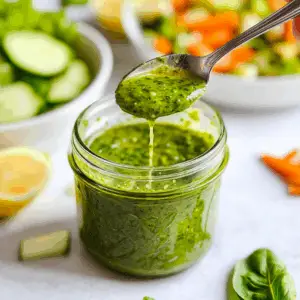
Basil Pesto Vinaigrette
Equipment
- Food processor or blender Crucial for achieving a smooth vinaigrette consistency. If you don’t have one, a mortar and pestle will work for the pesto, and you can whisk in the oil and vinegar by hand.
- Measuring cups and spoons Precision helps balance flavors in dressing vinaigrette.
- Mason jar or dressing bottle For storage and easy shaking before use.
- Rubber spatula To scrape down the sides and make sure every bit gets used.
Ingredients
- 1 cup fresh basil leaves: This is the heart of the pesto flavor. Make sure they are bright green and not wilted.
- 1/4 cup grated Parmesan cheese: Adds that savory umami that makes pesto shine.
- 2 tablespoons pine nuts: Toasted slightly to enhance their nutty flavor. You can substitute with walnuts or almonds for a twist.
- 1 garlic clove: Raw for a bit of bite or roast it if you want a mellow touch.
- 1/2 cup extra virgin olive oil: The base of your oil and vinegar salad dressing.
- 2 tablespoons white wine vinegar: Brings the acidic balance. You can also use apple cider vinegar or lemon juice.
- 1/2 teaspoon Dijon mustard: Optional but helps emulsify the vinaigrette and adds complexity.
- Salt and pepper to taste: Always taste and season at the end.
Instructions
Toast the Pine Nuts
- In a small dry skillet over medium heat, toast the pine nuts for about 3 minutes until golden and fragrant. Shake the pan often to prevent burning.
Blend the Base
- In your food processor, add the basil, Parmesan, garlic, and toasted pine nuts. Pulse a few times until roughly chopped.
Add the Acid and Emulsifier
- Pour in the white wine vinegar and Dijon mustard. Pulse again to incorporate.
Drizzle in the Oil
- With the motor running, slowly drizzle in the olive oil. This creates that creamy vinaigrette texture we love.
Season and Taste
- Add salt and pepper to your preference. Blend one final time and give it a taste test.
Store or Serve
- Pour the vinaigrette into a mason jar or bottle. Shake well before each use.